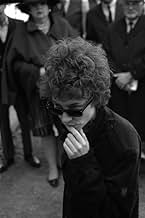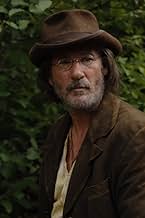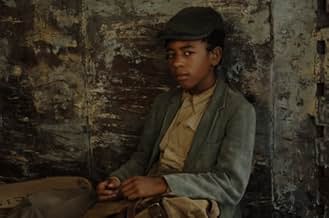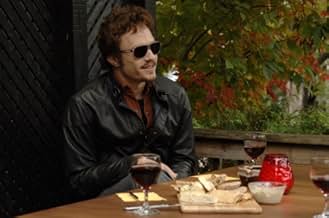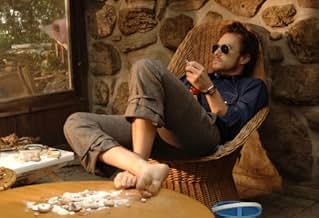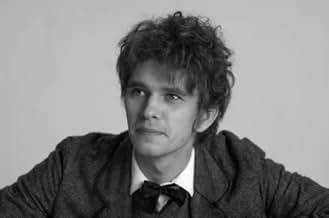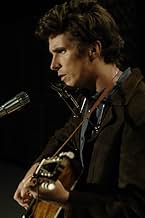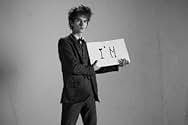IMDb रेटिंग
6.8/10
63 हज़ार
आपकी रेटिंग
अपनी भाषा में प्लॉट जोड़ेंRuminations on the life of Bob Dylan, where six characters embody a different aspect of the musician's life and work.Ruminations on the life of Bob Dylan, where six characters embody a different aspect of the musician's life and work.Ruminations on the life of Bob Dylan, where six characters embody a different aspect of the musician's life and work.
- 1 ऑस्कर के लिए नामांकित
- 29 जीत और कुल 49 नामांकन
Roc Lafortune
- Hobo Moe
- (as Roc LaFortune)
Brian R.C. Wilmes
- Circus Man
- (as Brian RC Wilmes)
फ़ीचर्ड समीक्षाएं
While not the biggest fan of Bob Dylan, a lot of his songs are great (especially in the lyric writing) and he has an immediately distinctive voice, he is a musician who is appreciated highly by me and it is easy to recognise his importance.
'I'm Not There', regardless of having a talented big name cast, generally didn't do much for me. It is interesting sure, with a unique and quite bold concept, but it doesn't come off completely successfully. There are things to appreciate but it is understandable why some may dislike it, it's pretty divisive as a film.
Starting with 'I'm Not There's' good points, it is beautifully and atmospherically made and adeptly directed by Todd Haynes. Dylan's music is just great and beautifully incorporated and interpreted.
A big strength is the cast, a vast majority of them giving strong performances. Cate Blanchett, barely recognisable, is particularly excellent, with Christian Bale, Marcus Carl Franklin and Heath Ledger more than up to her level. There are some entertaining secondary performances from Charlotte Gainsbourg, David Cross and Julianne Moore. Dylan is remarkably multi-faceted, where we see him as a rebellious poet, a protest singer, a drug-addled rock star, a matinée idol with marriage woes, and a born-again Christian.
Not everything works. The concept does intrigue, but the time shifts do feel muddled and confusing. 'I'm Not There' is overlong with it going longer than necessary and the pacing rambles making the film drag.
While most of the cast are great, Richard Gere and his story are tacked on and uninteresting and Ben Whishaw is a little dull. The script could have been tighter and more cohesive.
Overall, not awful but underwhelming and easy to see why it's a divisive film. Bob Dylan deserved better than this. 5/10 Bethany Cox
'I'm Not There', regardless of having a talented big name cast, generally didn't do much for me. It is interesting sure, with a unique and quite bold concept, but it doesn't come off completely successfully. There are things to appreciate but it is understandable why some may dislike it, it's pretty divisive as a film.
Starting with 'I'm Not There's' good points, it is beautifully and atmospherically made and adeptly directed by Todd Haynes. Dylan's music is just great and beautifully incorporated and interpreted.
A big strength is the cast, a vast majority of them giving strong performances. Cate Blanchett, barely recognisable, is particularly excellent, with Christian Bale, Marcus Carl Franklin and Heath Ledger more than up to her level. There are some entertaining secondary performances from Charlotte Gainsbourg, David Cross and Julianne Moore. Dylan is remarkably multi-faceted, where we see him as a rebellious poet, a protest singer, a drug-addled rock star, a matinée idol with marriage woes, and a born-again Christian.
Not everything works. The concept does intrigue, but the time shifts do feel muddled and confusing. 'I'm Not There' is overlong with it going longer than necessary and the pacing rambles making the film drag.
While most of the cast are great, Richard Gere and his story are tacked on and uninteresting and Ben Whishaw is a little dull. The script could have been tighter and more cohesive.
Overall, not awful but underwhelming and easy to see why it's a divisive film. Bob Dylan deserved better than this. 5/10 Bethany Cox
Haynes' adventurous biopic of Bob Dylan, which uses six actors of both sexes and several races ranging in ages from 11 to 50, is both exhausting and fun to watch. It's also hard to describe. But let's start with those six and the characters or facets they portray. Arthur (Ben Whishaw) is the Dylan who incarnated Rimbaud and serves as a kind of narrator whom we see smoking and giving ironic answers to some kind of inquisition sporadically throughout the film. Woody (the wonderful young Marcus Carl Franklin, an amazing a singer and actor) is a precocious rail-hopper with a guitar (labeled like the real Woody's, THIS MACHINE KILLS FASCISTS) and tall tales that start with his claim that he's Woody Guthrie. Woody's scenes show him rescued by a black family and a white family and performing with country black musicals. He represents the early shape-shifting Dylan in search of an identity and telling a lot of lies along the way.
Jack (Christian Bale) is the Dylan who became a hit in Greenwich Village and went into the South and sang "The Ballad of Hattie Carroll" and other protest "folk songs,"-the high-profile "political" Dylan who spearheaded a movement and became famous with his brilliant early LP's. But Jack doesn't want to be typecast and "betrays" his adoring public and his lover and folksinging champion Alice (Julianne Moore), a Joan Baez stand-in seen in later "interviews." Jack disappears and his place is taken by Robbie (Heath Ledger), a young actor in New York who becomes famous for starring in a 1965 film depicting the vanished Jack. Robbie meets Claire (Charlotte Gainsbourg) in a Village coffee shop and falls in love, and a turbulent ten-year marriage follows, winding up painfully at the time of the Vietnam War's end.
If Jack represents the cast-off early style and Robbie represents Dylan's family life, Jude (Cate Blanchett) is Dylan the artist, quintessentially as seen in the mid-to-late Sixties when he toured England (an event notably chronicled by two Leacock-Pennebaker documentaries)-and shocked his audiences, some of whose members felt betrayed and shouted "Judas!", when he shifted from solo guitar and harmonica to more personal songs with loud rock accompaniment. Jude's segments are partly borrowed from Pennebaker, but largely consist of gorgeous black and white scenes deliberately and "churlishly" (Haynes' word) imitative of Fellini's 8 ½.
Jude's new style is admired by Allen Ginsberg (David Cross) and underground groupie Coco Rivington (Michelle Williams) and he becomes internationally famous. But he continues to be misunderstood by the protest music old guard and conventional journalists like the British TV host Mr. Jones (Bruce Greenwood)-who's incorporated into a music video for Highway 61 Revisited's "Ballad of a Thin Man": ". . .something is happening here /And you don't know what it is, do you, Mister Jones." . .
Jude and Arthur articulate the early Dylan's challenging, ironic stance to the public, but Jude is exhausted on tour and his nihilism leads him to an existential crisis.
He's reborn symbolically in Pastor John (Christian Bale again), who's moved to Stockton twenty years later and become a born-again preacher, singing his own gospel songs. Finally the last version of Dylan appears in Billy (Richard Gere), in full retreat from the world till threats to destroy his town of Riddle cause him to enter public life again. This sequence evokes a Sixties historical western in which Pat Garrett (Bruce Greenwood) is a character.
This is only the barest outline of the two-and-a-quarter-hour film, in which various "Dylan's" are woven in and out. Maybe the reason why I found Woody's sequences delightful and Billy's colorful but wearying has to do with the latter's coming two hours later. But Gere and his sequences evoke Dylan less well and are puzzling to interpret. Blanchett's in contrast are, of course, the most conventionally straightforward. She's the only one who successfully mimics the physical appearance and the speaking voice of the artist (unless Whishaw does a better job with the voice). But Blanchett's mimicry is intentionally undercut (and the biopic conventionality of films like Ray avoided) by having Jude be played by a woman-which was planned by Haynes in his screenplay before he even chose his actor.
The method Haynes has chosen avoids cliché. This is still a biopic, but it's a sophisticated one; and the fractured portrait is well justified by the nature of its subject. Dylan has always been a shape-shifter; some of his permutations were left out, such as the period of the orthodox Jew and JDL supporter. But it's intelligent to see Dylan the man, the husband, the artist, the political being, and the religious being as completely separate entities because no simple biopic sequence can really dramatize the complexity of such an artist and such a protean existence. Haynes' film makes you think about biography itself, as well as giving imaginative shape to aspects of Bob Dylan no non-fiction account can really provide.
Maybe it's the daringly experimental methodology that led Dylan himself, approached through his eldest son Jesse, to grant Haynes both the musical rights and the biographical rights. Haynes has chosen a multifaceted and original way of using Dylan's songs. Only Franklin actually performs them with his own voice. Otherwise the soundtrack mixes original Dylan recordings with existing covers, new ones by people as widely various as Ritche Havens, Iggy Pop, John Doe and Sonic Youth, and other music, including, appropriately for the 8 ½- esque sequences, Nino Rota. There is a voice-over narration by Kris Kristofferson. Haynes worked on the screenplay for years, and then collaborated with Oren Moverman.
Not for mainstream audiences or be prime Oscar bait, but a challenging, fun watch.
Shown in the press screenings of the New York Film Festival at Lincoln Center 2007. Haynes was present for a Q&A afterward with J. Hoberman of the Village Voice, which revealed that the director is an intelligent and articulate man who knows his Dylan.
Jack (Christian Bale) is the Dylan who became a hit in Greenwich Village and went into the South and sang "The Ballad of Hattie Carroll" and other protest "folk songs,"-the high-profile "political" Dylan who spearheaded a movement and became famous with his brilliant early LP's. But Jack doesn't want to be typecast and "betrays" his adoring public and his lover and folksinging champion Alice (Julianne Moore), a Joan Baez stand-in seen in later "interviews." Jack disappears and his place is taken by Robbie (Heath Ledger), a young actor in New York who becomes famous for starring in a 1965 film depicting the vanished Jack. Robbie meets Claire (Charlotte Gainsbourg) in a Village coffee shop and falls in love, and a turbulent ten-year marriage follows, winding up painfully at the time of the Vietnam War's end.
If Jack represents the cast-off early style and Robbie represents Dylan's family life, Jude (Cate Blanchett) is Dylan the artist, quintessentially as seen in the mid-to-late Sixties when he toured England (an event notably chronicled by two Leacock-Pennebaker documentaries)-and shocked his audiences, some of whose members felt betrayed and shouted "Judas!", when he shifted from solo guitar and harmonica to more personal songs with loud rock accompaniment. Jude's segments are partly borrowed from Pennebaker, but largely consist of gorgeous black and white scenes deliberately and "churlishly" (Haynes' word) imitative of Fellini's 8 ½.
Jude's new style is admired by Allen Ginsberg (David Cross) and underground groupie Coco Rivington (Michelle Williams) and he becomes internationally famous. But he continues to be misunderstood by the protest music old guard and conventional journalists like the British TV host Mr. Jones (Bruce Greenwood)-who's incorporated into a music video for Highway 61 Revisited's "Ballad of a Thin Man": ". . .something is happening here /And you don't know what it is, do you, Mister Jones." . .
Jude and Arthur articulate the early Dylan's challenging, ironic stance to the public, but Jude is exhausted on tour and his nihilism leads him to an existential crisis.
He's reborn symbolically in Pastor John (Christian Bale again), who's moved to Stockton twenty years later and become a born-again preacher, singing his own gospel songs. Finally the last version of Dylan appears in Billy (Richard Gere), in full retreat from the world till threats to destroy his town of Riddle cause him to enter public life again. This sequence evokes a Sixties historical western in which Pat Garrett (Bruce Greenwood) is a character.
This is only the barest outline of the two-and-a-quarter-hour film, in which various "Dylan's" are woven in and out. Maybe the reason why I found Woody's sequences delightful and Billy's colorful but wearying has to do with the latter's coming two hours later. But Gere and his sequences evoke Dylan less well and are puzzling to interpret. Blanchett's in contrast are, of course, the most conventionally straightforward. She's the only one who successfully mimics the physical appearance and the speaking voice of the artist (unless Whishaw does a better job with the voice). But Blanchett's mimicry is intentionally undercut (and the biopic conventionality of films like Ray avoided) by having Jude be played by a woman-which was planned by Haynes in his screenplay before he even chose his actor.
The method Haynes has chosen avoids cliché. This is still a biopic, but it's a sophisticated one; and the fractured portrait is well justified by the nature of its subject. Dylan has always been a shape-shifter; some of his permutations were left out, such as the period of the orthodox Jew and JDL supporter. But it's intelligent to see Dylan the man, the husband, the artist, the political being, and the religious being as completely separate entities because no simple biopic sequence can really dramatize the complexity of such an artist and such a protean existence. Haynes' film makes you think about biography itself, as well as giving imaginative shape to aspects of Bob Dylan no non-fiction account can really provide.
Maybe it's the daringly experimental methodology that led Dylan himself, approached through his eldest son Jesse, to grant Haynes both the musical rights and the biographical rights. Haynes has chosen a multifaceted and original way of using Dylan's songs. Only Franklin actually performs them with his own voice. Otherwise the soundtrack mixes original Dylan recordings with existing covers, new ones by people as widely various as Ritche Havens, Iggy Pop, John Doe and Sonic Youth, and other music, including, appropriately for the 8 ½- esque sequences, Nino Rota. There is a voice-over narration by Kris Kristofferson. Haynes worked on the screenplay for years, and then collaborated with Oren Moverman.
Not for mainstream audiences or be prime Oscar bait, but a challenging, fun watch.
Shown in the press screenings of the New York Film Festival at Lincoln Center 2007. Haynes was present for a Q&A afterward with J. Hoberman of the Village Voice, which revealed that the director is an intelligent and articulate man who knows his Dylan.
This movie can be difficult to follow if you are not familiar with Bob Dylan, but it is in fact a carefully and lovingly crafted tribute, that aims to reflect the essence of the artist's work and life. It is a fun take on its subject, though in order to be fully appreciated, one has to know what is being explored. Otherwise, it may seem a tedious watch, but perhaps that is appropriate as in order to fully appreciate Bob Dylan, one has to pay attention, and then it becomes quite rewarding. The shape-shifting nature of Bob Dylan has been portrayed, quite fittingly, by several actors of various backgrounds, ages, sexes and races - in that respect, it is as original and unexpected as its subject. All in all, an interesting, artistic and original but perhaps somewhat inaccessible - to an uninitiated viewer - tribute to one of the greatest artistic geniuses Americana has ever reared.
'I'm Not There' Todd Haynes, 2007
The biopicture can be a difficult kind of picture to picture. Even more so when you have no intention of divulging the name of your subject. And dare I say it, yet further still when you insist on casting at least six people to play the lead role. This is the charm behind 'I'm Not There' - Todd Haynes' tribute to the life and times of Bob Dylan that recently lit up the Festival di Venezia. Biographic cinema is a frightening beast, some films are stuffed full of information while others attempt to exactly mimic their respective studies. There are however very few that play with their quarry, flitting from fact to fiction so quickly that in the end we know not what to believe. In reality, the life of Robert Dylan was exactly this mess of lies, grandeur, childishness, arrogance and genius. One of almost unbelievable occurrences that when whispered about long enough become carefully set in stone. Todd Haynes understands this fact and so goes after it with a stance of almost awed respect, yet as an onlooker - crafting a mockumentary that is so rich in character and love and attention to detail that we can't help but be drawn in. I've heard early reviews stating that 'I'm Not There' will make the Dylanites gush and the normal folk sleep. The fact is this couldn't be further from the truth - being a person that is indifferent to the music appears only to heighten the enjoyment.
Somewhere during the last five years, writer/director Haynes came upon the slightly trampled idea of conducting a Bob Dylan biography movie. Nothing original in itself, though with one idea to make it slightly different from what the likes of Scorsese had attempted a few years back. He would use multiple actors for 'I'm Not There', six in fact - to portray the iconic figure. And what an inspired decision it is. The unrecognisable and slender form of Cate Blanchett steals the show, melting into her eye-rubbing, nose-twitching, lip-conscious take that is only too quick to lash those in proximity with a witful tongue. Almost as idiosyncratic is Ben Whishaw's sarcasm-laced drawling poet Dylan. Who prompts guffaws when tiresomely declaring his name as "R-I-M-B-A-U-D" to an arresting police officer. The eccentric duo are displayed primarily in overexposed black and white, and complementing this in Technicolor are the equally impressive Christian Bale and Heath Ledger. Whom fall upon the unwashed, shaded rocker Dylan with equally strong performances. To complete the musical sextuplets are Richard Gere and the delightful Marcus Carl Franklin, these two are the tall-tale Dylans. A jaded western cowboy and a blues-singing black child respectively, both adding another more fictional dimension to the character. They are almost opposite ends of the Dylan-spectrum, and are introduced at the opening and closing of the film to further embolden this point. Franklin in particular impresses, tugging at the humor strings again with his dry recollections of a life on the musical road.
The host of supporting actors/actresses in 'I'm Not There' do well to further the films themes. With Charlotte Gainsbourg and Julianne Moore taking up the posts of drama and documentary accordingly. Each plays one of the two most important women in Dylan's life, with Gainsbourg (Sara Lownds) cooking up a memorable on-screen chemistry - or lack thereof - with Ledger's character. She is instantly attractive across a smoky diner, yet this attraction soon wanes as romance stagnates. Never-ending tours take their toll and the once exciteful, scooter-riding relationship crumbles. Moore's character (Joan Baez) is more reflective, playing her whole part as if interviewed enthusiastically many years on. My only problem is with the later segments of 'I'm Not There'. Particularly those featuring the bearded and bespectacled Richard Gere. Many know the story of Pat Garrett and Billy the Kid, and this part is essential when regarding the plot. My qualm is that it feels almost tacked on as an afterthought, trotting outside the clear themed borders that the film has laid out so meticulously. This only adds to the ballooning length of the film, and so did begin to drag during these Wild-western plot points. That said, this hardly takes away from an experience that is both visceral and enlightening. Comedic and pensive. Wild and tender. A life, in all possible senses of the word.
9/10
The biopicture can be a difficult kind of picture to picture. Even more so when you have no intention of divulging the name of your subject. And dare I say it, yet further still when you insist on casting at least six people to play the lead role. This is the charm behind 'I'm Not There' - Todd Haynes' tribute to the life and times of Bob Dylan that recently lit up the Festival di Venezia. Biographic cinema is a frightening beast, some films are stuffed full of information while others attempt to exactly mimic their respective studies. There are however very few that play with their quarry, flitting from fact to fiction so quickly that in the end we know not what to believe. In reality, the life of Robert Dylan was exactly this mess of lies, grandeur, childishness, arrogance and genius. One of almost unbelievable occurrences that when whispered about long enough become carefully set in stone. Todd Haynes understands this fact and so goes after it with a stance of almost awed respect, yet as an onlooker - crafting a mockumentary that is so rich in character and love and attention to detail that we can't help but be drawn in. I've heard early reviews stating that 'I'm Not There' will make the Dylanites gush and the normal folk sleep. The fact is this couldn't be further from the truth - being a person that is indifferent to the music appears only to heighten the enjoyment.
Somewhere during the last five years, writer/director Haynes came upon the slightly trampled idea of conducting a Bob Dylan biography movie. Nothing original in itself, though with one idea to make it slightly different from what the likes of Scorsese had attempted a few years back. He would use multiple actors for 'I'm Not There', six in fact - to portray the iconic figure. And what an inspired decision it is. The unrecognisable and slender form of Cate Blanchett steals the show, melting into her eye-rubbing, nose-twitching, lip-conscious take that is only too quick to lash those in proximity with a witful tongue. Almost as idiosyncratic is Ben Whishaw's sarcasm-laced drawling poet Dylan. Who prompts guffaws when tiresomely declaring his name as "R-I-M-B-A-U-D" to an arresting police officer. The eccentric duo are displayed primarily in overexposed black and white, and complementing this in Technicolor are the equally impressive Christian Bale and Heath Ledger. Whom fall upon the unwashed, shaded rocker Dylan with equally strong performances. To complete the musical sextuplets are Richard Gere and the delightful Marcus Carl Franklin, these two are the tall-tale Dylans. A jaded western cowboy and a blues-singing black child respectively, both adding another more fictional dimension to the character. They are almost opposite ends of the Dylan-spectrum, and are introduced at the opening and closing of the film to further embolden this point. Franklin in particular impresses, tugging at the humor strings again with his dry recollections of a life on the musical road.
The host of supporting actors/actresses in 'I'm Not There' do well to further the films themes. With Charlotte Gainsbourg and Julianne Moore taking up the posts of drama and documentary accordingly. Each plays one of the two most important women in Dylan's life, with Gainsbourg (Sara Lownds) cooking up a memorable on-screen chemistry - or lack thereof - with Ledger's character. She is instantly attractive across a smoky diner, yet this attraction soon wanes as romance stagnates. Never-ending tours take their toll and the once exciteful, scooter-riding relationship crumbles. Moore's character (Joan Baez) is more reflective, playing her whole part as if interviewed enthusiastically many years on. My only problem is with the later segments of 'I'm Not There'. Particularly those featuring the bearded and bespectacled Richard Gere. Many know the story of Pat Garrett and Billy the Kid, and this part is essential when regarding the plot. My qualm is that it feels almost tacked on as an afterthought, trotting outside the clear themed borders that the film has laid out so meticulously. This only adds to the ballooning length of the film, and so did begin to drag during these Wild-western plot points. That said, this hardly takes away from an experience that is both visceral and enlightening. Comedic and pensive. Wild and tender. A life, in all possible senses of the word.
9/10
To appreciate I’m Not There., you need to fully buy into its somewhat-implausible premise; in it, six actors represent various aspects of Bob Dylan throughout his many decades in the limelight. If you buy into this premise, then this is a unique, thoughtful perspective of an almost-unknowable individual, a man who famously played things close to the vest, a man who shunned introspection. But if you don’t immediately buy into this premise, then the movie just feels like a long experiment that isn’t entirely successful, and in the end you don’t feel you know much more about the man, the myth, the legend than you knew going in. Which might be the point, who’s to say? And that’s sort of where I land on the whole I’m Not There. issue.
Here’s one big problem right off the bat. The six various characters, each representing part of Dylan, have different names. Some of them are named after real-life people, like Woody Guthrie and Arthur Rimbaud. Some have fictitious names, like Jude Quinn (an amalgam of Jude from “Hey Jude” and Dylan’s own “The Mighty Quinn”), Jack Rollins, and Robbie Clark - the latter being an actor playing one of the aspects in a movie. And then it gets confusing.
The first gimmick for this movie is that each aspect is played by an actor you wouldn’t expect to see playing Dylan. Okay, maybe not all of them, but some of them. Cate Blanchett is one. She’s female, in case you were unsure, and she is by far the best Dylan in the movie. She plays Jude, the latter-day, peeved-at-everyone Dylan. Another is Marcus Carl Franklin, who plays “Woody Guthrie” - here, a young version of Dylan, riding the rails across the Midwest. Franklin is African American. Then there’s Heath Ledger and Christian Bale, who are Australian (as is Blanchett) and Welsh, respectively. The problem with those, though, is that the only difference between them and the real Dylan is Dylan’s particular linguistic tendencies, so you wind up with just some guys acting Dylanesque. You know, the perpetual cigarette dangling precariously, the hat, the whole nine yards.
It would have been more effective, for me, if each of the aspects was played by completely different looking people - because in order for them to be identifiable as Dylan, they would have to sound like him. Otherwise you’re left with some folk-singing iconoclast who’s rebelling against everyone, and you don’t know why. So there’s one issue. And that would have been a clever, but not too-clever, way for each supposed aspect or time period to be represented. Even if two aspects were on the screen simultaneously, big deal - at least we could tell who was who.
But added to this gimmick is the fact that some non-Dylan characters - and some situations - are based on real-life people, like Allen Ginsburg, and retain their counterparts’ names, and others are clearly supposed to be real people but have … different names. And some situations definitely did occur (such as Dylan’s getting booed at the Newport festival, a huge turning point for him), but did all of them? Were any of them made up to highlight that particular aspect of his personality? One of the characters is Arthur Rimbaud. No, not the poet, he just has that name. Anyway, the entirety of his screen time is spent giving testimony or something to officials (or a jury, I’m not sure). And his speeches are of the deep philosophical sort, the kind that Dylan was apparently fond of - ways to get into people’s minds, but I’m not sure what the soliloquies add in terms of exposition and revelation.
Then there’s also Richard Gere, who plays Billy the Kid, another “aspect” of Dylan. Apparently here Billy is mythologized as this hiding loner at the end of his career, just sort of like Dylan, only Dylan’s not even now at the end of his career, unless he keels over tomorrow, or something. Gere’s good, and I don’t say that often, but I think the aspect, such as it is, is too abstract and unreadable to be worthwhile.
The intermittent narrator (Kris Kristofferson) is marginally helpful; perhaps he could have been used to tie all these aspects together. Instead we get two hours of ego feeding and idol worship. To me, though, it felt more like idle worship than anything else, a waste of time even if you’re willing to grasp whatever deep insights the film pretends to offer to you.
Here’s one big problem right off the bat. The six various characters, each representing part of Dylan, have different names. Some of them are named after real-life people, like Woody Guthrie and Arthur Rimbaud. Some have fictitious names, like Jude Quinn (an amalgam of Jude from “Hey Jude” and Dylan’s own “The Mighty Quinn”), Jack Rollins, and Robbie Clark - the latter being an actor playing one of the aspects in a movie. And then it gets confusing.
The first gimmick for this movie is that each aspect is played by an actor you wouldn’t expect to see playing Dylan. Okay, maybe not all of them, but some of them. Cate Blanchett is one. She’s female, in case you were unsure, and she is by far the best Dylan in the movie. She plays Jude, the latter-day, peeved-at-everyone Dylan. Another is Marcus Carl Franklin, who plays “Woody Guthrie” - here, a young version of Dylan, riding the rails across the Midwest. Franklin is African American. Then there’s Heath Ledger and Christian Bale, who are Australian (as is Blanchett) and Welsh, respectively. The problem with those, though, is that the only difference between them and the real Dylan is Dylan’s particular linguistic tendencies, so you wind up with just some guys acting Dylanesque. You know, the perpetual cigarette dangling precariously, the hat, the whole nine yards.
It would have been more effective, for me, if each of the aspects was played by completely different looking people - because in order for them to be identifiable as Dylan, they would have to sound like him. Otherwise you’re left with some folk-singing iconoclast who’s rebelling against everyone, and you don’t know why. So there’s one issue. And that would have been a clever, but not too-clever, way for each supposed aspect or time period to be represented. Even if two aspects were on the screen simultaneously, big deal - at least we could tell who was who.
But added to this gimmick is the fact that some non-Dylan characters - and some situations - are based on real-life people, like Allen Ginsburg, and retain their counterparts’ names, and others are clearly supposed to be real people but have … different names. And some situations definitely did occur (such as Dylan’s getting booed at the Newport festival, a huge turning point for him), but did all of them? Were any of them made up to highlight that particular aspect of his personality? One of the characters is Arthur Rimbaud. No, not the poet, he just has that name. Anyway, the entirety of his screen time is spent giving testimony or something to officials (or a jury, I’m not sure). And his speeches are of the deep philosophical sort, the kind that Dylan was apparently fond of - ways to get into people’s minds, but I’m not sure what the soliloquies add in terms of exposition and revelation.
Then there’s also Richard Gere, who plays Billy the Kid, another “aspect” of Dylan. Apparently here Billy is mythologized as this hiding loner at the end of his career, just sort of like Dylan, only Dylan’s not even now at the end of his career, unless he keels over tomorrow, or something. Gere’s good, and I don’t say that often, but I think the aspect, such as it is, is too abstract and unreadable to be worthwhile.
The intermittent narrator (Kris Kristofferson) is marginally helpful; perhaps he could have been used to tie all these aspects together. Instead we get two hours of ego feeding and idol worship. To me, though, it felt more like idle worship than anything else, a waste of time even if you’re willing to grasp whatever deep insights the film pretends to offer to you.
क्या आपको पता है
- ट्रिवियाTodd Haynes needed to get approval from Bob Dylan to use his music, since (unlike in his Velvet Goldmine (1998) where David Bowie did not give his permission for his music) he felt the film would not work without it. At the encouragement of Dylan's manager, Haynes wrote a one-page summary of his concept and the characters, which Dylan approved. It took another 6 years to get the film made due to funding difficulties.
- गूफ़When Woody's character is first seen he is running towards a train going North but when he is sitting on the train, it is noticeably going South.
- भाव
Billy the Kid: People are always talking about freedom. Freedom to live a certain way, without being kicked around. Course the more you live a certain way, the less it feel like freedom. Me, uhm, I can change during the course of a day. I wake and I'm one person, when I go to sleep I know for certain I'm somebody else. I don't know who I am most of the time.
- क्रेज़ी क्रेडिटThe way the title appears on the screen at the opening would read: I he I'm her not her not here. I'm not there" (period included).
- साउंडट्रैकGoin' to Acapulco
Performed by Jim James and Calexico
Written by Bob Dylan
Published by Dwarf Music (SESAC)
Produced by Joey Burns
Jim James appears courtesy of ATO Records
Calexico appears courtesy of Quarterstick Records
टॉप पसंद
रेटिंग देने के लिए साइन-इन करें और वैयक्तिकृत सुझावों के लिए वॉचलिस्ट करें
- How long is I'm Not There?Alexa द्वारा संचालित
- I don't understand why all the actors who play Dylan have different names. Someone explain this to me.
- What does the title mean?
विवरण
- रिलीज़ की तारीख़
- कंट्री ऑफ़ ओरिजिन
- आधिकारिक साइटें
- भाषा
- इस रूप में भी जाना जाता है
- Mi historia sin mi
- फ़िल्माने की जगहें
- उत्पादन कंपनियां
- IMDbPro पर और कंपनी क्रेडिट देखें
बॉक्स ऑफ़िस
- बजट
- $2,00,00,000(अनुमानित)
- US और कनाडा में सकल
- $40,17,609
- US और कनाडा में पहले सप्ताह में कुल कमाई
- $7,30,819
- 25 नव॰ 2007
- दुनिया भर में सकल
- $1,17,92,542
- चलने की अवधि2 घंटे 15 मिनट
- रंग
- ध्वनि मिश्रण
- पक्ष अनुपात
- 2.35 : 1
इस पेज में योगदान दें
किसी बदलाव का सुझाव दें या अनुपलब्ध कॉन्टेंट जोड़ें





